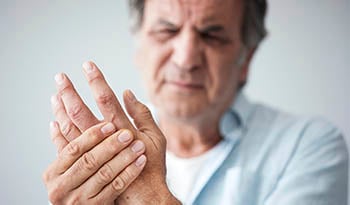How to Manage Parkinson’s Naturally
DISCLAIMER:This blog does not intend to provide diagnosis...
- In this article:
- What Is Parkinson’s Disease?
- Pharmaceuticals Are A Mainstay of Parkinson’s Disease—Here’s Why
- How to Use Optimize Parkinson’s Disease Medications With Nutrition
- Movement: The Mainstay of Natural Treatment for PD
- Dietary Changes for Parkinson’s Disease Management
- Supplements for Parkinson’s Disease Management

There have been many advances in medicine that allow people with Parkinson’s to maximize their health, happiness, and well-being. In this article, we’ll cover some of the basics about Parkinson’s Disease (PD), including what it is, how to manage it, and some natural methods for improving outcomes.
What Is Parkinson’s Disease?
Parkinson’s Disease (PD) is a neurodegenerative disorder that affects roughly 1% of the world’s population. PD impacts the whole body, including the musculoskeletal system (fine and gross motor control), autonomic and nervous system, digestive system, mood, cognition, and more. Symptoms of PD are typically grouped into categories called “motor” and “non-motor” symptoms.
In the past few decades, our understanding of PD has progressed from one that was defined by a lack of dopaminergic neurons in the substantia nigra of the brain and tremor to a more complete understanding of PD as a whole-body disorder which begins decades before we can see changes in central nervous system tissue. PD also involves multiple neurotransmitters (not just dopamine), and highly progressive forms of PD are linked with chronic inflammation, cell damage, protein glycation, high blood sugar, lack of activity, poor dietary choices, and more.
While this might feel overwhelming to hear, it means that there are tons of evidence-based, natural, lifestyle-based changes you can make to decrease your risk of Parkinson’s and to potentially decrease your symptoms if you already have it. Remember, health happens the 364 days you spend outside of the doctor’s office each year. Your choices at the dinner table, in the gym, and in your home affect your health and you can use them to improve many disorders, including Parkinson’s disease. Let’s talk about the variety of exciting, easy interventions that are proven to improve outcomes in PD.
Pharmaceuticals Are A Mainstay of Parkinson’s Disease—Here’s Why
You might be wondering, “Why is Dr. Kate’s number one ‘natural’ recommendation to take and optimize pharmaceutical medications?” Simply put, it’s because if you don’t have enough dopamine in your brain, you can’t do any of the other lifestyle changes I’ll be asking you to do later in this article. Pharmaceuticals are a mainstay of Parkinson’s disease treatment because they help to replace missing dopamine that your brain desperately needs to stay motivated and to keep moving.
Dopamine’s Role in the Brain and Body
Dopamine is the reward neurotransmitter that helps us feel motivated to do things like get outside, cook healthy meals, and exercise. It also helps us coordinate movement. When people with Parkinson’s don’t have enough dopamine, they can get symptoms like depression, apathy, fatigue, tremor, and poor balance. They can even experience freezing—a phenomenon in Parkinson’s disease where people feel stuck or unable to move.
It’s not hard to imagine how the symptom list above would make it difficult—if not impossible—to go out for a run, take medications consistently, or want to go to the grocery store to look for ingredients for a new plant-based recipe (other natural interventions that are proven to reduce progression in Parkinson’s). These symptoms can even make it hard to take supplements or eat healthy foods since a lack of dopamine can cause difficulties with swallowing. For that reason, we need to make sure dopamine levels are optimized first before we try other natural treatment options in PD.
Dopaminergic drugs and in particular Levodopa (also known as Sinemet, Rytary, Carbidopa-Levodopa, or Duopa), are the closest things to our own body’s dopamine that we can make in a lab. They work. I’ve seen people with Parkinson’s who couldn’t stand up, take a step, or smile become completely transformed within hours of taking their first dose of Levodopa. In my opinion and the opinions of most neurologists, PD specialists, and PD patients, dopaminergic drugs are effective medications. They just have to be taken the right way and with the right nutrients to make them work for you.
How to Use Optimize Parkinson’s Disease Medications With Nutrition
There are a number of ways to optimize your response to oral medications for Parkinson’s disease. One of the first is to make sure that you’re digesting and absorbing those medications adequately. For PD medications, in particular, there are several nutritional considerations you must factor in when designing a medication plan that works for you.
1. Take PD medications with small snacks, not meals
Dopaminergic medications need to be taken away from high-fat, high-protein meals because amino acids and peptides compete for absorption across the blood-brain barrier, and high-volume meals can dilute stomach acid and delay the absorption of medication into the bloodstream. If you eat a big steak with your dopamine meds, they won’t be absorbed as well as if you ate them with a lower-protein snack like an apple.
Because of the need to avoid combining protein with dopaminergic medications, people with Parkinson’s have to be very careful to make sure they still get enough total protein in the day and that they optimize their nutrition. Protein is important because it helps our bodies heal, repair tissues, and balance blood sugar, among many other things. It pays to work with a naturopathic doctor, registered dietitian, or nutritionist who can help you develop a plan that works for you to still optimize your nutrition while you increase your ability to absorb medications. Some of my strategies for PD patients involve an adjusted feeding schedule, protein shakes between meals, small and frequent snacks throughout the day, and collagen powders in drinks that my clients don’t take with meds.
2. Take B vitamins when taking dopaminergic meds
Additionally, the human body also requires cofactors like vitamin B6, choline, zinc, and vitamin B12 to metabolize and use dopaminergic pharmaceuticals. A deficiency in these vitamins and minerals can impair your ability to respond to dopaminergic medications effectively and without side effects.
Many people are surprised to learn that deficiencies in B6 and B12 are quite common. Roughly 10% of the U.S. population is deficient in B6, and 2% is deficient in B12. Because the top food sources of B vitamins tend to also be protein sources like beans and meat, people with Parkinson’s may actually be at a higher risk of these deficiencies if they’ve been attempting an unsupervised low-protein diet.
Consider taking a B complex or multivitamin that contains at least 100% RDA of B vitamins and zinc to make sure you’ve got enough of these nutrients to allow dopaminergic drugs to work their magic! If you have trouble swallowing, sublingual B12 or a liquid multivitamin may be the best option for you. Studies have shown that repleting levels of B12 and folate can help to minimize adverse reactions to L-Dopa-containing medications and protect nerve and cardiovascular tissue long-term.
3. Drink enough water and electrolytes to avoid orthostatic hypotension
One of the most common side effects of dopaminergic medications is orthostatic hypotension. Symptoms of orthostatic hypotension including feeling dizzy when you stand up, feeling fatigued due to low blood pressure, and frequent brain fog. Orthostatic hypotension also increases the chances of falling while walking. To help to reduce the chances of experiencing orthostatic hypotension when taking dopaminergic medication, make sure to drink enough fluids like water, decaffeinated teas, and low-sugar sports drinks, consume adequate electrolytes, and to consume enough protein. These factors combined help to ensure your best chances of maintaining normal blood pressure.
A Word about Natural Dopamine Replacement
Clients often ask me if they can use mucuna pruriens to help treat their PD instead of dopaminergic pharmaceuticals like Levodopa. The answer is that it depends.
Mucuna is a plant that contains significant amounts of L-Dopa. Some studies suggest that it can be as effective as Levodopa for controlling motor symptoms in PD and that it can have fewer side effects. These studies have mainly been conducted in remote areas where access to pharmaceutical medications is limited.
Currently, mucuna is not available as a prescription. This means that it is not subject to the same purity and safety regulations as pharmaceutical drugs are in the U.S. Taking it means that you’re accepting the risk that it might be contaminated or that it may contain more or less of a product that is on the label. It also isn’t covered by insurance, so the cost of taking mucuna daily is often prohibitive for many of my clients when compared to the cost of Levodopa.
If you’re willing to accept these risks and drawbacks, then mucuna could be a good herbal medicine for you to include in your PD treatment program. You have to work closely with a doctor (ideally one like a naturopathic doctor who’s also trained in herbal medicine) to determine and continually adjust your ideal dose of it.
It’s worth noting here that many other medications can be used to help manage Parkinson’s symptoms. This article is a good starting point for learning how to use lifestyle to optimize dopaminergic pharmaceuticals, but if you have more questions, schedule an appointment with a neurologist who specializes in PD and ask them what might work best for your body.
Movement: The Mainstay of Natural Treatment for PD
Now that you’ve got enough dopamine in your system, your next best bet is to get moving! Exercise is one of the most effective interventions for Parkinson’s symptoms—second only to dopaminergic medication.
You should always work with a physical therapist to determine which exercises are safe for you depending on your symptoms and abilities. But the key takeaway from this section should be that regular exercise improves overall outcomes, quality of life, and nearly all symptoms of Parkinson’s disease.
Whether it’s balance, fall risk, depression, energy, strength, speed of movement, or sleep, there’s at least one study proving that exercise can help improve it in Parkinson’s. It sounds simple, but it’s profound.
Some of the most studied forms of exercise for improving PD symptoms include:
- Strength training
- Balance training
- Dance, including tango and foxtrot
- Yoga
- Running
- Boxing
How to Use Movement as Medicine in PD
Movement is mostly free. It’s available to all of us, and it really works to improve symptoms of PD. But getting regular movement can feel tricky if you’re already someone who has a hard time with balance, strength, or motivation.
This is why you need good movement specialists on your team. Whether it’s a physical therapist, personal trainer, chiropractor, coach, or fitness instructor, create a community of folks who can help you determine how to move safely in a way that you love so you can stay active with PD in the long term.
This is also why we talked about medications first in this section. Medications can help you to minimize motor symptoms and maximize your ability to get moving so that you can begin to practice a program that will eventually build strength, flexibility, and balance.
Additionally, because apathy and depression are often symptoms of PD, it can be hard to motivate yourself to exercise. Get friends and join a boxing group, hiking club, or pilates class. Agree to walk dogs for a local shelter, or volunteer to take younger relatives to a park. Whatever it takes to keep you accountable for moving, build it into your schedule so that your other symptoms don’t derail your movement progress. If you don’t have a community locally, find one online.
Finally, it’s worth reiterating that moving safely is the foundation for any exercise program that works long-term. Get a medical professional (physical therapist, orthopedic doctor, etc.) on board to help you determine how you can move in a way that’s best for your body, and then make a commitment to do it each day.
Dietary Changes for Parkinson’s Disease Management
In general, a diet that is adequate in vitamins, minerals, low-glycemic fiber, complete proteins, and water is more beneficial for PD and other neurodegenerative diseases than one that is high in inflammatory oils, processed sugars, and excess calories. This is because protecting nerve fibers and cell membranes is critical for keeping folks with PD healthy, and to do this we have to:
- Provide our cells with what they need to work correctly (vitamins and minerals)
- Reduce the food ingredients that cause cellular damage via inflammation, toxicity, and impaired cell signaling (inflammatory oils, processed sugars, and excess calories).
Plant foods (fruits, vegetables, tubers, nuts, seeds, legumes) and moderate amounts of animal protein are the most beneficial foods for people with Parkinson’s to eat because they accomplish both of these goals.
Some people use diets like the Mediterranean diet, DASH diet, Wahls diet, Whole 30 diet, or other specific diets as a shorthand way of describing the diet outlined above. In general, though, a whole foods diet that includes many fruits and vegetables is the best for someone with PD.
One fascinating study, in particular, has established that the following foods seem to be associated with a dose-dependent decrease in PD symptoms long-term. (Put differently, the more of these foods you eat, the better you feel when you have Parkinson’s).
- Fresh vegetables
- Fresh fruit
- Nuts
- Fish
- Olive oil
- Turkey
- Coconut oil
- Fresh herbs
- Spices
- Eggs
- Bread
- Beans
The same study suggested that sodas, canned foods, and fried foods, as well as processed sources of dairy, seem to be linked with faster rates of Parkinson’s progression (i.e. worse outcomes) long-term.
I typically advise my patients to focus on adding more of the foods in the list above to their diets, rather than restricting their diets. Simply including two servings of fruits or vegetables at each meal, adding more trail mix and nut or seed-based snacks throughout their day, and eating omega-3 rich fish like salmon several times per week can help you get there.
If you need more specific advice, consider working with a naturopathic doctor or nutrition professional to help you create a plan that’s customized for you. If you have trouble swallowing, work with an OT and your neurologist to develop a plan to help you eat the healthiest foods in a safe way for you.
Low-Glycemic Diets Improve Symptoms in PD
Managing blood sugar is vitally important for people with neurodegenerative disorders like PD. This is because hyperglycemia and diabetes are risk factors for mitochondrial dysfunction, impaired blood flow and oxygen delivery to organs including the brain, reduced brain volume, and more. All of these effects make the symptoms of PD worse.
Any dietary plan should include low-glycemic foods like fiber-rich fruits, vegetables, grains, legumes, and protein sources. If you have high blood sugar, ask your doctor and nutrition practitioner to help you get it under control.
Supplements for Parkinson’s Disease Management
Many people with Parkinson’s take supplements as part of their health routines. In a study of supplement habits in people with PD, the following supplements appear to be associated with a decreased rate of progression of PD symptoms.
CoQ10 is an important antioxidant that helps our cells make energy. Because mitochondrial dysfunction and impaired cellular energy metabolism are implicated in the development of Parkinson’s disease, it makes sense to ensure that you are—at the very least—not deficient. One of the ways to do this is to supplement regularly with an over-the-counter CoQ10 supplement. In animal studies, CoQ10 supplementation has even been shown to halt or reverse the progression of Parkinsonian symptoms.
5MTHF stands for 5-methyl-tetrahydrafolate. It’s a methylated form of folate that’s thought to be more bioavailable than folic acid. Many people with PD take this as a part of the protocol recommended at the beginning of this article to maximize the effectiveness (and reduce side effects) of some Parkinson’s medications.
Turmeric, resveratrol, and quercetin are thought to protect cell membrane health mostly via their antioxidant capabilities. Antioxidants quench free radicals that would normally damage the fatty lining of every single cell in our bodies. By doing this, they protect cell membrane health and preserve the ability of our cells to manufacture energy and signal to each other appropriately.
Multivitamins also contain many minerals and vitamins that are antioxidants. Additionally, they can be part of a good holistic plan to prevent nutrient deficiencies, which helps any human feel healthier and maximize their chances of good health. These supplements are safe for most people, but you should always ask your health provider before adding them to your routine.
There are many reasons to feel empowered and hopeful about your ability to manage and thrive with Parkinson’s disease. I hope this article gives you a good start!
References:
- Bus, Christine, et al. “Human Dopaminergic Neurons Lacking PINK1 Exhibit Disrupted Dopamine Metabolism Related to Vitamin B6 Co-Factors.” IScience, vol. 23, no. 12, Dec. 2020, p. 101797, www.ncbi.nlm.nih.gov/pmc/articles/PMC7702004/, 10.1016/j.isci.2020.101797. Accessed 30 Mar. 2021.
- Centers for Disease Control and Prevention, et al. CDC’s Second Nutrition Report: A Comprehensive Biochemical Assessment of the Nutrition Status of the U.S. Population Report Measures 58 Indicators of Diet and Nutrition New Report Uses NHANES Results. 2012.
- Cilia, Roberto, et al. “Mucuna Pruriens in Parkinson Disease.” Neurology, vol. 89, no. 5, 5 July 2017, pp. 432–438, www.ncbi.nlm.nih.gov/pmc/articles/PMC5539737/, 10.1212/wnl.0000000000004175. Accessed 30 Mar. 2021.
- Corcos, Daniel M., et al. “A Two-Year Randomized Controlled Trial of Progressive Resistance Exercise for Parkinson’s Disease.” Movement Disorders, vol. 28, no. 9, 27 Mar. 2013, pp. 1230–1240, www.ncbi.nlm.nih.gov/pmc/articles/PMC3701730/, 10.1002/mds.25380. Accessed 27 Mar. 2021.
- Dorszewska, Jolanta, et al. “Molecular Effects of L-Dopa Therapy in Parkinson’s Disease.” Current Genomics, vol. 15, no. 1, 31 Mar. 2014, pp. 11–17, www.ncbi.nlm.nih.gov/pmc/articles/PMC3958954/, 10.2174/1389202914666131210213042. Accessed 30 Mar. 2021.
- Ellis, Terry, and Lynn Rochester. “Mobilizing Parkinson’s Disease: The Future of Exercise.” Journal of Parkinson’s Disease, vol. 8, no. s1, 18 Dec. 2018, pp. S95–S100, www.ncbi.nlm.nih.gov/pmc/articles/PMC6311359/, 10.3233/jpd-181489. Accessed 30 Mar. 2021.
- Elstner, Matthias, et al. “Single-Cell Expression Profiling of Dopaminergic Neurons Combined with Association Analysis Identifies Pyridoxal Kinase as Parkinson’s Disease Gene.” Annals of Neurology, vol. 66, no. 6, Dec. 2009, pp. 792–798, www.ncbi.nlm.nih.gov/pmc/articles/PMC4034432/, 10.1002/ana.21780. Accessed 30 Mar. 2021.
- Enzinger, C., et al. “Risk Factors for Progression of Brain Atrophy in Aging: Six-Year Follow-up of Normal Subjects.” Neurology, vol. 64, no. 10, 23 May 2005, pp. 1704–1711, pubmed.ncbi.nlm.nih.gov/15911795/, 10.1212/01.wnl.0000161871.83614.bb. Accessed 30 Mar. 2021.
- Fereshtehnejad, Seyed-Mohammad, et al. “Evolution of Prodromal Parkinson’s Disease and Dementia with Lewy Bodies: A Prospective Study.” Brain, vol. 142, no. 7, 20 May 2019, pp. 2051–2067, pubmed.ncbi.nlm.nih.gov/31111143/, 10.1093/brain/awz111. Accessed 30 Mar. 2021.
- Giardini, Marica, et al. “Instrumental or Physical-Exercise Rehabilitation of Balance Improves Both Balance and Gait in Parkinson’s Disease.” Neural Plasticity, vol. 2018, 2018, pp. 1–17, www.ncbi.nlm.nih.gov/pmc/articles/PMC5863303/, 10.1155/2018/5614242. Accessed 27 Mar. 2021.
- Guilarte, Tomas R. “Effect of Vitamin B-6 Nutrition on the Levels of Dopamine, Dopamine Metabolites, Dopa Decarboxylase Activity, Tyrosine, and GABA in the Developing Rat Corpus Striatum.” Neurochemical Research, vol. 14, no. 6, June 1989, pp. 571–578, pubmed.ncbi.nlm.nih.gov/2761676/, 10.1007/bf00964920. Accessed 30 Mar. 2021.
- Hackney, ME, and GM Earhart. “Effects of Dance on Movement Control in Parkinson’s Disease: A Comparison of Argentine Tango and American Ballroom.” Journal of Rehabilitation Medicine, vol. 41, no. 6, 2009, pp. 475–481, www.ncbi.nlm.nih.gov/pmc/articles/PMC2688709/, 10.2340/16501977-0362. Accessed 27 Mar. 2021.
- Hunter, Randy L., et al. “Intrastriatal Lipopolysaccharide Injection Induces Parkinsonism in C57/B6 Mice.” Journal of Neuroscience Research, vol. 87, no. 8, June 2009, pp. 1913–1921, www.ncbi.nlm.nih.gov/pmc/articles/PMC2692550/, 10.1002/jnr.22012. Accessed 30 Mar. 2021.
- Mao, Cheng-jie, et al. “Serum Sodium and Chloride Are Inversely Associated with Dyskinesia in Parkinson’s Disease Patients.” Brain and Behavior, vol. 7, no. 12, 9 Nov. 2017, p. e00867, www.ncbi.nlm.nih.gov/pmc/articles/PMC5745246/, 10.1002/brb3.867. Accessed 30 Mar. 2021.
- Mischley, Laurie K., et al. “Role of Diet and Nutritional Supplements in Parkinson’s Disease Progression.” Oxidative Medicine and Cellular Longevity, vol. 2017, 2017, pp. 1–9, www.ncbi.nlm.nih.gov/pmc/articles/PMC5610862/, 10.1155/2017/6405278. Accessed 30 Mar. 2021.
- Muthukumaran, Krithika, et al. “Orally Delivered Water Soluble Coenzyme Q10 (Ubisol-Q10) Blocks On-Going Neurodegeneration in Rats Exposed to Paraquat: Potential for Therapeutic Application in Parkinson’s Disease.” BMC Neuroscience, vol. 15, no. 1, 2014, p. 21, www.ncbi.nlm.nih.gov/pmc/articles/PMC3917573/, 10.1186/1471-2202-15-21. Accessed 31 Mar. 2021.
- NHANES - National Health and Nutrition Examination Survey Homepage. 2021, www.cdc.gov/nchs/nhanes/index.htm. Accessed 30 Mar. 2021.
- “Office of Dietary Supplements - Vitamin B6.” Nih.gov, 2017, ods.od.nih.gov/factsheets/VitaminB6-HealthProfessional/. Accessed 30 Mar. 2021.
- “Office of Dietary Supplements - Vitamin B12.” Nih.gov, 2017, ods.od.nih.gov/factsheets/VitaminB12-HealthProfessional/. Accessed 30 Mar. 2021.
- Oguh, O., et al. “Back to the Basics: Regular Exercise Matters in Parkinson’s Disease: Results from the National Parkinson Foundation QII Registry Study.” Parkinsonism & Related Disorders, vol. 20, no. 11, Nov. 2014, pp. 1221–1225, pubmed.ncbi.nlm.nih.gov/25258329/, 10.1016/j.parkreldis.2014.09.008. Accessed 30 Mar. 2021.
- Petzinger, Giselle M, et al. “Exercise-Enhanced Neuroplasticity Targeting Motor and Cognitive Circuitry in Parkinson’s Disease.” The Lancet Neurology, vol. 12, no. 7, July 2013, pp. 716–726, www.ncbi.nlm.nih.gov/pmc/articles/PMC3690528/, 10.1016/s1474-4422(13)70123-6. Accessed 27 Mar. 2021.
- Ramya KB;Thaakur S. “Herbs Containing L- Dopa: An Update.” Ancient Science of Life, vol. 27, no. 1, 2019, pubmed.ncbi.nlm.nih.gov/22557260/, . Accessed 30 Mar. 2021.
- Renaud, Justine, et al. “The Sweet Road to Parkinson’s Disease.” Aging, vol. 11, no. 3, 1 Feb. 2019, pp. 853–854, www.ncbi.nlm.nih.gov/pmc/articles/PMC6382427/, 10.18632/aging.101806. Accessed 30 Mar. 2021.
- Seppi, Klaus, et al. “Update on Treatments for Nonmotor Symptoms of Parkinson’s Disease—an Evidence‐Based Medicine Review.” Movement Disorders, vol. 34, no. 2, 17 Jan. 2019, pp. 180–198, www.ncbi.nlm.nih.gov/pmc/articles/PMC6916382/, 10.1002/mds.27602. Accessed 30 Mar. 2021.
- Sergi, Domenico, et al. “Diabetes, a Contemporary Risk for Parkinson’s Disease: Epidemiological and Cellular Evidences.” Frontiers in Aging Neuroscience, vol. 11, 8 Nov. 2019, www.ncbi.nlm.nih.gov/pmc/articles/PMC6856011/, 10.3389/fnagi.2019.00302. Accessed 30 Mar. 2021.
- Sivandzade, Farzane, et al. “NRF2 and NF-ҚB Interplay in Cerebrovascular and Neurodegenerative Disorders: Molecular Mechanisms and Possible Therapeutic Approaches.” Redox Biology, vol. 21, Feb. 2019, p. 101059, www.ncbi.nlm.nih.gov/pmc/articles/PMC6302038/, 10.1016/j.redox.2018.11.017. Accessed 30 Mar. 2021.
- Vicente Miranda, Hugo, et al. “Glycation in Parkinson’s Disease and Alzheimer’s Disease.” Movement Disorders, vol. 31, no. 6, 4 Mar. 2016, pp. 782–790, pubmed.ncbi.nlm.nih.gov/26946341/, 10.1002/mds.26566. Accessed 30 Mar. 2021.
- Wu, Pei-Ling, et al. “Effectiveness of Physical Activity on Patients with Depression and Parkinson’s Disease: A Systematic Review.” PLOS ONE, vol. 12, no. 7, 27 July 2017, p. e0181515, www.ncbi.nlm.nih.gov/pmc/articles/PMC5531507/, 10.1371/journal.pone.0181515. Accessed 27 Mar. 2021.
- Yang, Lichuan, et al. “Combination Therapy with Coenzyme Q10and Creatine Produces Additive Neuroprotective Effects in Models of Parkinson’s and Huntington’s Diseases.” Journal of Neurochemistry, vol. 109, no. 5, June 2009, pp. 1427–1439, www.ncbi.nlm.nih.gov/pmc/articles/PMC2866530/, 10.1111/j.1471-4159.2009.06074.x. Accessed 31 Mar. 2021.

 By Dr. Kate Henry, N.D.
By Dr. Kate Henry, N.D.


